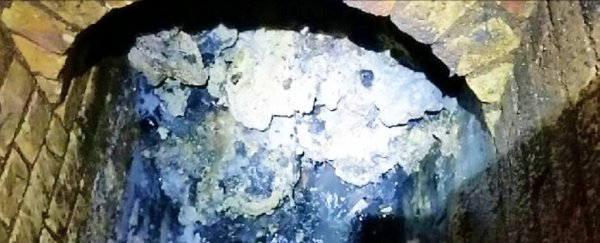They're the vilest, most unthinkable horrors you could ever imagine lurking in the sewers underneath our cities. Even Pennywise is terrified of them.
They're called fatbergs: vast deposits of congealed fat and grease stuck together with soiled diapers, condoms, tampons, wet wipes, you name it. But these stomach-churning accumulations that clog up sewer systems could actually be a force for good, new research shows.
A team from the University of British Columbia in Canada says the fatty aggregates that make up fatbergs – fats, oils, and grease, aka FOG – can be broken down and repurposed as a source of biofuel.
"FOG is a terrific source of organic material that microorganisms can feed on to produce methane gas, which is a valuable, renewable energy source," explains one of the researchers, environmental engineer Asha Srinivasan.
"By preheating it to the right temperature, we ensure that the FOG is ready for the final treatment and can make the maximum amount of methane."
In their newly developed technique, the researchers heat the fatty deposits up to temperatures between 90 and 110 degrees Celsius (194 to 230 degrees Fahrenheit), and mix in hydrogen peroxide, which kickstarts the breakdown process.
In the team's experiments, this can reduce the FOG component of fatbergs by as much as 80 percent of their volume, which could be a massive help in unclogging metropolitan sewer systems that get obstructed by "monster" accretions of filth that are difficult to dislodge by conventional means.
"This fatberg is up there with the biggest we've ever seen," Matt Rimmer of Thames Water explained last year in relation to a giant fatberg the size of 20 elephants that was clogging the sewers under Whitechapel, London.
"It's a total monster and taking a lot of manpower and machinery to remove as it's set hard. It's basically like trying to break up concrete."
That fatberg was so disgustingly notorious in fact that a sample of it is now on display at the Museum of London, and you can even watch a livestream of it breaking down the old-fashioned way (read: slowly), without scientists' assistance.
Of course, even when that assistance is administered, the new technique is no silver bullet. The hydrogen peroxide bake-off only breaks down the 'fat' component of the fatberg.
The other half of this sticky problem – let's call it the 'berg' – is a nasty stockpile of condoms, sanitary pads, and other random detritus that should never have gone down the drain in the first place.
It's up to you and me to stop that part of the equation from happening, but at least the FOG 'glue' in the mix can now be treated, and according to the team, it shouldn't be too difficult to apply the new method to existing sewer systems.
"Anaerobic digestion systems commonly exist in municipal sewage treatment plants," Srinivasan explained to Inverse.
"So, it would be advantageous to make use of the existing infrastructure to produce methane."
The team is currently investigating pilot tests various sewage treatment plants and dairy farms, and hope to have a full-scale system working in the next two years, which could then be rolled out to sewers and sewage treatment facilities.
There's more research to be done – and we still don't know how economically scalable the method will be – but if everything works out, fatbergs may not be a problem for future sewers, and the system could also help farmers treat farm waste.
You had a good ride, fatbergs, but it's over. We're through.
The findings are reported in Water, Air, & Soil Pollution.
